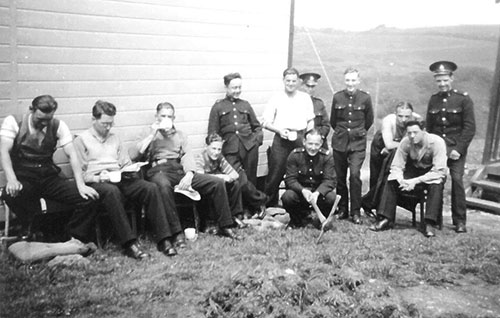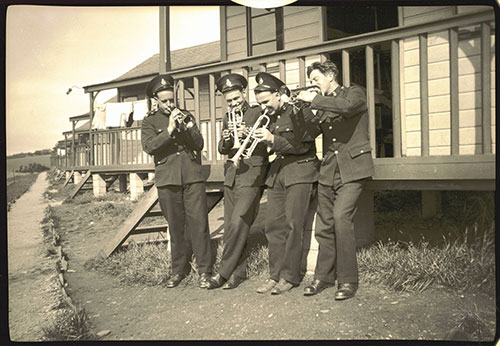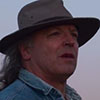This year, the BBC Proms 2013 celebrate the composer George Lloyd’s centenary year with a performance of his HMS Trinidad March at the Last Night of The Proms on 7 September 2013. George’s nephew Bill Lloyd tells us the story behind the march and George’s experiences aboard HMS Trinidad during the Arctic Convoys.
My uncle George Lloyd participated in the Arctic Convoys during the Second World War and in 1941 he composed a march for the Royal Marine Band of HMS Trinidad, the ship that he sailed upon. The orchestral arrangement that will be performed at The Proms was completed by George in 1945 while he was recovering from Post-Traumatic Stress Disorder, following an attack on his ship.
George was only 26 when war was declared in September 1939. He had already gained considerable recognition as a composer: the 1938 Oxford Companion to Music described him as “a youthful prodigy” and his first opera Iernin had played in the West End.
George enlisted in the Royal Marines as a bandsman. After basic training, George was immediately promoted to the position of leading violin. He was also asked to learn the cornet!
In the Royal Marines George studied gunnery before joining HMS Trinidad, one of the fastest and most technically advanced vessels in the Navy’s fleet. Along with the other bandsmen, George worked in the ship’s transmitting station calculating the exact elevation and bearing that the gun turrets required in order to hit enemy ships. George operated the telephone switchboard, relaying orders to the bridge and the gunnery control tower because his loud voice could carry over the deafening noise of the guns. This role would ultimately save his life as the switchboard was located close to the exit ladder of the transmitting station.
When HMS Trinidad was commissioned on 14 October 1941, bandmaster Harold A Davis asked George to write the ship’s official march. Unbeknown to Harold, a friend of the ship’s captain, the composer Ralph Vaughan Williams, had also been invited to write a march. The captain agreed to listen to both men’s marches and decide which was to be used. Vaughan Williams’ march was not popular with the bandsmen and when both pieces were premiered in the ship’s aircraft hangar, the captain announced that George’s music would be adopted as the HMS Trinidad’s official march. George’s rousing march echoes the role of the Fantasia on British Sea Songs traditionally played at the Last Night of the Proms, with its links to the Navy and its catchy tunes and up tempo rhythms, which encourage audience participation.

In January 1942, HMS Trinidad was selected for Arctic convoy escort duties to Murmansk through a narrow stretch of water between the North Cape and the pack ice, which was heavily patrolled by German submarines and the Luftwaffe.
On 23 March 1942, after two successful convoys, HMS Trinidad was deployed as close escort for 20 merchant ships in convoy PQ13. However, near the start of the voyage, high winds forced the convoy to separate – only for it to be attacked by German U-boats when it reassembled.
Three German destroyers sailed from Norway to intercept the convoy but on the morning of 29 March 1942, the German ships were picked up on HMS Trinidad’s radar. In the poor visibility, HMS Trinidad launched a surprise attack, hitting two German ships and evading the torpedo fired from the third. HMS Trinidad however was hit by a shell which caused a fire towards its stern. With minimal damage HMS Trinidad relocated the third German ship and opened fire again, hitting the destroyer several times and causing serious damage, as well as setting it on fire.
In an attempt to finish off the enemy destroyer, HMS Trinidad fired three torpedoes. Two of the torpedoes failed to leave their iced-up tubes and the third malfunctioned and circled back, striking HMS Trinidad below the bridge. The torpedo blew a 60×20 foot hole in the port side of the ship, and emerged from the starboard side blowing a further 20×10 foot hole.
George was the last man to escape from the transmitting station after it began to flood with the ship’s oil. 32 men were killed in the attack including 17 men in the transmitting station, nine of whom were bandsmen.
On 13 May 1942 following temporary repairs, HMS Trinidad was being escorted back to the UK when enemy aircraft, U-boats and destroyers surrounded the convoy. HMS Trinidad evaded most of the attacks but four bombs dropped by German aircraft set the ship alight. The fire was fatal to HMS Trinidad and the ship sank in the early hours of 15 May 1942 taking a further 63 men with her.
By mid-April, George had been admitted to the Royal Naval Auxiliary Hospital at Kingseat in Aberdeen, which treated cases of severe shell shock. Initially, George was unable to walk or speak, and his body was heavily contaminated with oil. His vision was affected and his muscles were torn and swollen into lumps. As the initial concussion wore off, he developed a profound and severe shaking of his limbs and his head, a contorted facial expression and periodic blackouts.
Three weeks later Nancy, George’s wife, received a letter from her husband who, in child-like writing, told her what had happened. Despite having been told by George that she was not to see him in his current state, Nancy travelled to Aberdeen immediately and proceeded to visit him every day.
With great persistence, Nancy persuaded George’s doctor to discharge him into her care and she then began the long slow task of nursing him back to health. George was not an easy patient. He refused to meet anyone and refused to speak unless Nancy prompted him. His shaking was still so bad that he was unable to walk far and he suffered from recurring nightmares, flashbacks and depression.
By the summer of 1944, after two years of care, George began to regain his strength and start gardening. Within weeks of the war ending in 1945, George and Nancy travelled to Nancy’s home in Switzerland, where they had met and married nine years earlier. George was having fewer blackouts and less frequent nightmares, and had recovered sufficiently to be able to hold a pen and write normally. He was a civilian once again, and with a small naval disability pension to live on, he began to think about returning to work as a composer.
In January 1946, George decided to start by orchestrating the HMS Trinidad March. The manuscript for the march had been safely in George’s kit bag when he was taken to hospital, otherwise it would have gone to the bottom of the sea when the ship sank. Within a few months he had persuaded Ernest Ansermet to perform it with the Orchestre de la Suisse Romande. The recording was broadcast on Swiss National Radio.

It was a long hard road, but within a year or two George was composing some of his finest works – his Fourth and Fifth Symphonies were both written in Switzerland.
Although George tried his best to re-establish his career by writing to every prominent conductor, orchestra and broadcaster in Europe and the USA, by 1952 he had realised that his psychological health could not stand the pressures of life in the fast lane – opera production and symphony concerts were simply too stressful, and he was too volatile, too easily upset, and too susceptible to depression and mood swings. He made a conscious decision that his composition was more important than performance, and that his priority was to recover his mental strength.
One hundred years earlier in 1848, George’s hero, Giuseppe Verdi, suffering from a mental block that prevented him from composing, retreated to the country and became a farmer. George followed suit. He and Nancy bought a tiny cottage with an acre of land near Sherborne in Dorset and set about earning their living as market gardeners.
With Nancy’s help and the therapeutic effects of physical labour, George gradually rehabilitated himself. He built his own greenhouses and sheds, and while Nancy took care of the picking and packing, George raised carnations and tomatoes from seed. Within a year or two, George and Nancy’s blooms were gaining top prices at Covent Garden Market. George rose early every morning in order to write music.
Forty years later, George said: “People ask me, ‘wasn’t that a terrible waste of time, to be out of the music scene for so long’ and I tell them ‘Not at all – I had no choice. I got my health back.’ If it was good enough for Verdi, it was good enough for me!”
A full account of George’s time at the Royal Marines School of Music, and details of the events surrounding the torpedo strike on HMS Trinidad, all taken from contemporary letters, can be downloaded from www.georgelloyd.com which also has biographical details and audio samples.
Our exhibition Arctic Convoys was at the National War Museum until March 2014. It told the story of the ocean-going convoys of merchant and military ships that provided an essential lifeline to the Russians in their fight against Germany in the Second World War.
